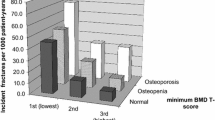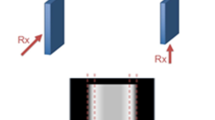Abstract
Summary
Bone mineral density (BMD) as assessed by dual energy X-ray absorptiometry (DXA) constitutes the gold standard for osteoporosis diagnosis. However, DXA does not take into account bone microarchitecture alterations.
Introduction
The aim of our study was to evaluate the ability of trabecular bone score (TBS) at lumbar spine to discriminate subjects with hip fracture.
Methods
We presented a case–control study of 191 Spanish women aged 50 years and older. Women presented transcervical fractures only. BMD was measured at lumbar spine (LS-BMD) using a Prodigy densitometer. TBS was calculated directly on the same spine image. Descriptive statistics, tests of difference and univariate and multivariate backward regressions were used. Odds ratio (OR) and the ROC curve area of discriminating parameters were calculated.
Results
The study population consisted of 83 subjects with a fracture and 108 control subjects. Significant lower spine and hip BMD and TBS values were found for subjects with fractures (p < 0.0001). Correlation between LS-BMD and spine TBS was modest (r = 0.41, p < 0.05). LS-BMD and TBS independently discriminate fractures equally well (OR = 2.21 [1.56–3.13] and 2.05 [1.45–2.89], respectively) but remain lower than BMD at neck or at total femur (OR = 5.86 [3.39–10.14] and 6.06 [3.55–10.34], respectively). After adjusting for age, LS-BMD and TBS remain significant for transcervical fracture discrimination (OR = 1.94 [1.35–2.79] and 1.71 [1.15–2.55], respectively). TBS and LS-BMD combination (OR = 2.39[1.70-3.37]) improved fracture risk prediction by 25 %.
Conclusion
This study shows the potential of TBS to discriminate subjects with and without hip fracture. TBS and LS-BMD combination improves fracture risk prediction. Nevertheless, BMD at hip remains the best predictor of hip fracture.


Similar content being viewed by others
References
WHO Study Group (1994) Assessment of fracture risk and its application to screening for postmenopausal osteoporosis. World Health Organ Tech Rep Ser 843:1–129
Cooper C, Campion G, Melton LJ 3rd (1992) Hip fractures in the elderly: a world-wide projection. Osteoporos Int 2(6):285–289
NIH Consensus Development Panel on Osteoporosis Prevention Diagnosis and Therapy (2001) Osteoporosis prevention, diagnosis, and therapy. JAMA 285:785–795
Johnell O, Kanis JA, Oden E, Johansson H, De Laet C, Delmas P, Eisman JA, Fujiwara S, Kroger H, Mellstrom D, Meunier PJ, Melton LJ, O'Neill T, Pols H, Reeve J, Silman A, Tenenhouse A (2005) Predictive value of BMD for hip and other fractures. J Bone Miner Res 20:1185–1194
Rice JC, Cowin SC, Bowman JA (1988) On the dependence of the elasticity and strength of cancellous bone on apparent density. J Biomech 21:155–168
Compston J (2009) Monitoring osteoporosis treatment. Best Pract Res Clin Rheumatol 23(6):781–788
Hordon LD, Raisi M, Paxton S, Beneton MM, Kanis JA, Aaron JE (2000) Trabecular architecture in women and men of similar bone mass with and without vertebral fracture: Part I. 2-D histology. Bone 27:271–276
McClung MR (2006) Do current management strategies and guidelines adequately address fracture risk? Bone 38(S2):13–17
Seeman E, Delmas PD (2006) Bone quality—the material and structural basis of bone strength and fragility. N Engl J Med 354:2250–2261
Frost HM (1963) Bone remodeling dynamics. Henry Ford Hospital Surgical Monograph. Springfield, Charles C. Thomas
Glüer CC (1999) Monitoring skeletal changes by radiological techniques. J Bone Miner Res 14(11):1952–1962
Ito M, Ikeda K, Nishiguchi M, Shindo H, Uetani M, Hosoi T, Orimo H (2005) Multidetector row CT imaging of vertebral microstructure for evaluation of fracture risk. J Bone Miner Res 20(10):1828–1836
Patel PV, Prevrhal S, Bauer JS, Phan C, Eckstein F, Lochmüller EM, Majumdar S, Link TM (2005) Trabecular bone structure obtained from multislice spiral computed tomography of the calcaneus predicts osteoporotic vertebral deformities. J Comput Assist Tomogr 29(2):246–253
Riggs BL, 3rd Melton LJ, Robb RA, Camp JJ, Atkinson EJ, Peterson JM, Rouleau PA, McCollough CH, Bouxsein ML, Khosla S (2004) Population-based study of age and sex differences in bone volumetric density, size, geometry, and structure at different skeletal sites. J Bone Miner Res 19:1945–1954
Manske SL, Liu-Ambrose T, Cooper DM, Kontulainen S, Guy P, Forster BB, McKay HA (2009) Cortical and trabecular bone in the femoral neck both contribute to proximal femur failure load prediction. Osteoporos Int 20(3):445–453
Holzer G, von Skrbensky G, Holzer LA, Pichl W (2009) Hip fractures and the contribution of cortical versus trabecular bone to femoral neck strength. J Bone Miner Res 24(3):468–474
Piveteau T, Winzenrieth R, Hans D (2011) Trabecular bone score (TBS) the new parameter of 2D texture analysis for the evaluation of 3D bone micro architecture status. J Clin Densitom 14(2):169
Winzenrieth R, Piveteau T, Hans D (2011) Assessment of correlations between 3D μCT microarchitecture parameters and TBS: effects of resolution and correlation with TBS DXA measurements. J Clin Densitom 14(2):169
Hans D, Barthe N, Boutroy S, Pothuaud L, Winzenrieth R, Krieg MA (2011) Correlations between trabecular bone score, measured using anteroposterior dual-energy X-ray absorptiometry acquisition, and 3-dimensional parameters of bone microarchitecture: an experimental study on human cadaver vertebrae. J Clin Densitom 14(3):302–312
Pothuaud L, Barthe N, Krieg M-A, Mehsen N, Carceller P, Hans D (2009) Evaluation of the potential use of TBS to complement BMD in the diagnosis of osteoporosis: a preliminary spine BMD-matched, case–control study. J Clin Densitom 12:170–176
Rabier B, Héraud A, Grand-Lenoir C, Winzenrieth R, Hans D (2010) A multicentre, retrospective case–control study assessing the role of trabecular bone score (TBS) in menopausal Caucasian women with low areal bone mineral density (BMDa): analysing the odds of vertebral fracture. Bone 46(1):176–181
Winzenrieth R, Dufour R, Pothuaud L, Hans D (2010) A retrospective case–control study assessing the role of trabecular bone score in postmenopausal Caucasian women with osteopenia: analyzing the odds of vertebral fracture. Calcif Tissue Int 86(2):104–109
Colson F, Winzenrieth R (2011) Assessment of osteopenic women microarchitecture with and without osteoporotic fracture by TBS on a new generation bone densitometer. J Clin Densitom 14(2):169
Hans D, Goertzen A, Krieg MA, Leslie W (2011) Bone micro-architecture assessed by tbs predicts hip, clinical spine and all osteoporotic fractures independently of BMD in 22234 women aged 50 and older: the Manitoba Prospective Study. J Bone Miner Res 26(11):2762–2769
Boutroy S, Hans D, Sornay-Rendu E, Vilayphiou N, Winzenrieth R, Chapurlat R (2011) Trabecular bone score helps classifying women at risk of fracture: a prospective analysis within the OFELY Study. Osteoporos Int 22(S1):S362
Breban S, Kolta S, Briot K, Paternotte S, Ghazi M, Fechtenbaum J, Dougados M, Roux C (2010) Combination of bone mineral density and trabecular bone score for vertebral fracture prediction in secondary osteoporosis. J Bone Miner Res 25(S1):S188
Maury E, Guignat L, Winzenrieth R, Cormier C (2005) BMD and TBS microarchitecture parameter assessment at spine in patient with anorexia nervosa. J Bone Miner Res 25(S1):S86
Colson F, Picard A, Rabier B, Vignon E (2009) Trabecular bone microarchitecture alteration in glucocorticoids treated women in clinical routine?: a TBS evaluation. J Bone Miner Res 24(S1):129
Kanis JA, Glüer CC (2000) An update on the diagnosis and assessment of osteoporosis with densitometry. Committee of Scientific Advisors, International Osteoporosis Foundation. Osteoporos Int 11(3):192–202
Bousson V, Le Bras A, Roqueplan F, Kang Y, Mitton D, Kolta S, Bergot C, Skalli W, Vicaut E, Kalender W, Engelke K, Laredo JD (2006) Volumetric quantitative computed tomography of the proximal femur: relationships linking geometric and densitometric variables to bone strength. Role for compact bone. Osteoporos Int 17(6):855–864
Eastell R, Mosekilde L, Hodgson SF, Riggs BL (1990) Proportion of human vertebral body bone that is cancellous. J Bone Miner Res 5:1237–1241
Bell KL, Garrahan N, Kneissel M, Loveridge N, Grau E, Stanton M, Reeve J (1996) Cortical and cancellous bone in the human femoral neck: evaluation of an interactive image analysis system. Bone 19(5):541–548
Alonso CG, Curiel MD, Carranza FH, Cano RP, Peréz AD (2000) Femoral bone mineral density, neck-shaft angle and mean femoral neck width as predictors of hip fracture in men and women. Multicenter Project for Research in Osteoporosis. Osteoporos Int 11(8):714–720
Cheng X, Li J, Lu Y, Keyak J, Lang T (2007) Proximal femoral density and geometry measurements by quantitative computed tomography: association with hip fracture. Bone 40(1):169–174
Gnudi S, Ripamonti C, Gualtieri G, Malavolta N (1999) Geometry of proximal femur in the prediction of hip fracture in osteoporotic women. Br J Radiol 72:729–733
Schott AM, Cormier C, Hans D, Favier F, Hausherr E, Dargent-Molina P, Delmas PD, Ribot C, Sebert JL, Breart G, Meunier PJ (1998) How hip and whole-body bone mineral density predict hip fracture in elderly women: the EPIDOS Prospective Study. Osteoporos Int 8(3):247–254
Kaptoge S, Beck TJ, Reeve J, Stone KL, Hillier TA, Cauley JA, Cummings SR (2008) Prediction of incident hip fracture risk by femur geometry variables measured by hip structural analysis in the study of osteoporotic fractures. J Bone Miner Res 23(12):1892–1904
Thomas CD, Mayhew PM, Power J, Poole KE, Loveridge N, Clement JG, Burgoyne CJ, Reeve J (2009) Femoral neck trabecular bone: loss with aging and role in preventing fracture. J Bone Miner Res 24(11):1808–1818
Kanis JA, McCloskey EV, Johansson H, Strom O, Borgstrom F, Oden A, National Osteoporosis Guideline Group (2008) Case finding for the management of osteoporosis with FRAX—assessment and intervention thresholds for the UK. Osteoporos Int 19(10):1395–1408
Acknowledgments
We would like to give special thanks to Helene Ward for orthographic and grammatical corrections of the manuscript.
Conflicts of interest
Renaud Winzenrieth was a consultant for Med-Imaps.
Author information
Authors and Affiliations
Corresponding author
Rights and permissions
About this article
Cite this article
Del Rio, L.M., Winzenrieth, R., Cormier, C. et al. Is bone microarchitecture status of the lumbar spine assessed by TBS related to femoral neck fracture? A Spanish case–control study. Osteoporos Int 24, 991–998 (2013). https://doi.org/10.1007/s00198-012-2008-8
Received:
Accepted:
Published:
Issue Date:
DOI: https://doi.org/10.1007/s00198-012-2008-8




